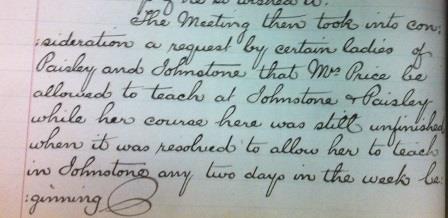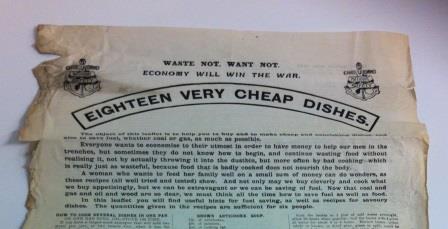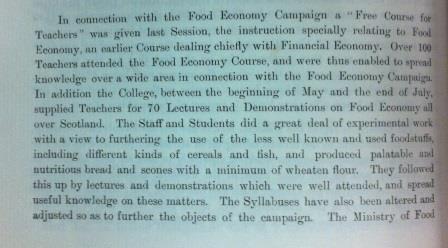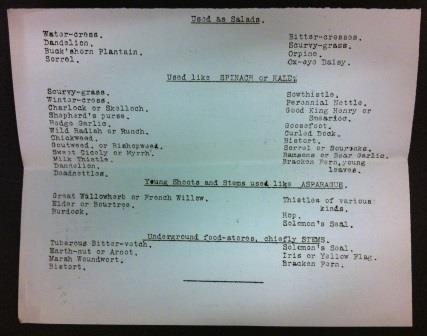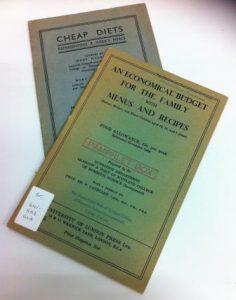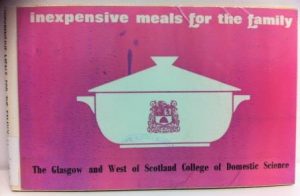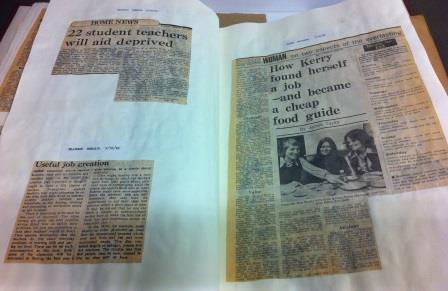A Wellcome Trust Research Resources Project
Over the festive season people are busy shopping, partying and feasting on rich food. For many, it is a time of extravagance and over-indulgence but it is also a time to remember that there are people who are less fortunate and need help to avoid poverty and hunger.
At the end of the 19th century, it was families struggling on low incomes that the Glasgow School of Cookery (GSC) and West End School of Cookery aimed to help, not just within their own walls, but by taking their knowledge and expertise out into the community. Teaching staff travelled widely around Glasgow and the towns and villages further afield, including Paisley, Port Glasgow, Greenock, Coatbridge, Helensburgh and Lennoxtown. Based in local board schools or public halls they gave talks, demonstrations and practical classes on hygiene, nutrition and how to cook healthy meals on a low budget.
Education out in the community continued after the two schools merged to become the Glasgow and West of Scotland College of Domestic Science (GWSCDS), but within 6 years of amalgamation, the College found itself having to help with the nation at war. It was not just people on low incomes that suffered from food poverty but everyone, as WW1 resulted in food shortages across the country. As skilled labourers went off to war there were not enough people to work on the farms or to manufacture and mend equipment used in food production. Many of the merchant ships were commandeered by the armed forces and those that did transport civilian supplies were at risk of being destroyed by the enemy. On top of the disruption caused by war, there was a world-wide wheat crop failure in 1916, so wheat-based foodstuffs were in very short supply.
The College soon found itself involved in the Food Economy Campaign run by the Ministry of Food, to encourage people to make efficient use of the food that was available. The College staff and students did experimental work with alternative ingredients to provide nutritious meals and advised the Ministry on cooking and nutrition for its campaign. They also travelled round the country giving talks and demonstrations on how to cook with less fuel, how to make the most of scraps, cooking to preserve nutrition and using alternative ingredients.
Nowadays people pay a premium to eat in restaurants using ingredients foraged from the wild but during the war using these wild alternatives was a necessity for everyone. Who would have thought to use the young stems of willowherb as a replacement for asparagus or dock leaves in place of spinach?
After the war the focus on food economy continued and students were taught about efficient cooking and household management. In March 1930 at an exhibition of students’ work, visitors were shown the model flat at the college where diploma students learned to manage a household and pay for lighting, heating and food for a family of 2 adults and 3 children on a budget of £4 per week.
When WW2 began the college resumed its advisory and community work, much as it had done during WW1. As well as public demonstrations the College also produced a number of recipe booklets, such as Cheap Diets and An Economical Budget for the Family with Menus and Recipes, putting into print what they were teaching. The booklets provided sample daily menus with recipes and shopping lists showing costs and nutritional content, all aiming to feed a family on 25 shillings a week. In 1973 the College reproduced this concept, with the book Inexpensive meals for the family which updated the menus and costings from the 1940s, with menus to feed a family on £8 a week.
- GWSCDS budget recipes booklets, 1939
- GWSCDS budget recipes book, 1973
The concept of educating disadvantaged people about cooking and nutrition out in their communities has also continued. In October 1976 the college received funding from the Manpower Services Commission to send 22 unemployed home economics graduates to give talk-ins on food nutrition and cooking to the elderly, single parents, people with special dieting needs, and under-privileged families. The students were directed by medical and health professionals within Glasgow clinics who advised on those most at need from the specialist help. They visited local shops to see what was was in season and the best value then used those ingredients to devise nutritionally balanced meals that individuals could easily cook at low cost.
The records in the archives show how staff at the College have learned from the past and re-introduced tried and tested methods to help educate people about cooking nutritious food on a low budget over the decades. In the 21st Century the battle against food poverty continues, as does the importance of eating nutritionally balanced meals. People are perhaps now better informed on how to eat better, as food packaging contains nutritional information with traffic light coding to show the healthier options, but poverty is still a problem. Who knows what the future may hold but we can hope that in 22nd Century we will have learned from the past and succeeded in overcoming food poverty for all.
Kirsty Menzies
Wellcome Trust funded Project Archivist
